- Administrator
- Albums and Singles

Italian electro-acoustic composers Giuseppe Ielasi and Nicola Ratti reconvene their unique Bellows collaborative project for a new album on Shelter Press.
Continuously drawing an hypnotic maze with albums on Boomkat Editions, Entr’acte, and Ielasi’s cult Senufo label, Bellows offers their first album on Shelter Press with Strand.
Clocking right under 40 minutes, Strand is direct and disorienting. With eight tactile but distant untitled tracks, the album convokes a complex sound palette between acousmatic sound and fractal beats.
Recorded in Milano at their very own Standards recording studio, Strand marks a shift in Bellows previous recording process, bringing more music gear on the table: tapes, modular synthesizers, effects and samples. Captured live over the course of a four days improvised session, the album floats between ghostly melodies, musique concrète, and analog electronics.
Echoing with the artwork by Amsterdam-based artist Louis Reith, whose collages made of found black and white images are disrupted by bold geometric constructions, the album is disorienting and fascinating, seating right in between the challenging world of electro-acoustic and a more welcoming beat-oriented territory.
Strand is a fascinating body of work, growing over time and revealing more of its complexity at every listen.
More information can be found here.
Read More
- Administrator
- Albums and Singles

"Out of the crystal clear and warm cosmic perennial waters comes forth another sparkling jewel from Anahita (Tara Burke (Fursaxa) and Helena Espvall (Espers). Two elves dancing amidst gnarled branches of ancient trees and fragrant herbs, concocting a magical potion for the mind of floating medieval cello spheres and melancholic ceremonial madrigals under the blinking eye of a pale moon and far off constellations of shooting stars."
–Bart De Paepe, founder of the Belgian tape label Sloow Tapes
More information can be found here.
Read More
- Administrator
- Albums and Singles
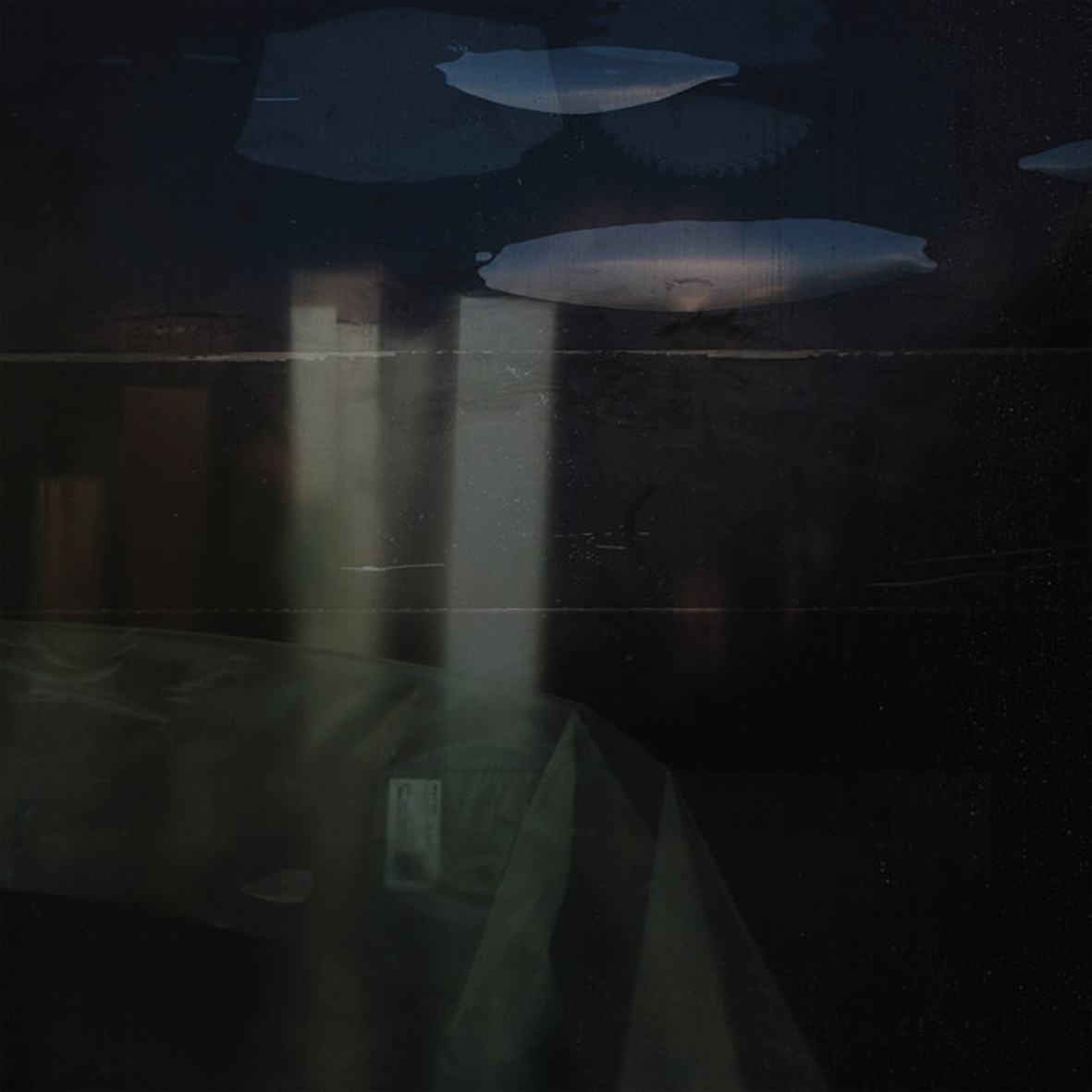 This is the debut release from Swedish chanteuse Irma Orm, an album that Kranky has been eagerly anticipating for a couple of years after receiving an anonymous and mysterious invitation to hear some early recordings.  If I had to guess why the album took so long to complete, I would venture to say that one of those early pieces was probably the opening "Niorum" and that Orm has spent the entire time trying in vain to recapture that brilliance.  She admittedly succeeds at least once, but the bulk of Nektyr sounds like a stark, time-stretched, and drifting marriage of This Mortal Coil and the Twin Peaks soundtrack that is shrouded in shadow and artfully blurred into dream-like soft-focus.  I suppose the highlights sound a lot like that too, but Nektyr works best when there is a skeleton of a hooky song lurking amidst all the darkness and fog.
This is the debut release from Swedish chanteuse Irma Orm, an album that Kranky has been eagerly anticipating for a couple of years after receiving an anonymous and mysterious invitation to hear some early recordings.  If I had to guess why the album took so long to complete, I would venture to say that one of those early pieces was probably the opening "Niorum" and that Orm has spent the entire time trying in vain to recapture that brilliance.  She admittedly succeeds at least once, but the bulk of Nektyr sounds like a stark, time-stretched, and drifting marriage of This Mortal Coil and the Twin Peaks soundtrack that is shrouded in shadow and artfully blurred into dream-like soft-focus.  I suppose the highlights sound a lot like that too, but Nektyr works best when there is a skeleton of a hooky song lurking amidst all the darkness and fog.
Orm describes her aesthetic as "doom pop," which is probably the most concise description of Nektyr that anyone could possibly venture.  That said, it is a bit too simple and reductionist to truly capture how unusual Demen's aesthetic can be, as many of these pieces are quite vaporous and experimental and the only real "pop" element is Orm's strong and soulful (if reverb-swathed) voice.  Also, even if the definition of "pop" is stretched to include torch songs, Orm still manages to occasionally elude its constraints.  For example, a piece like "Illdrop" sometimes sounds like an undead Siren luring a hapless ship through a thick fog to grisly and macabre doom.  More significantly, Orm seems to have zero interest in the structural restraints of conventional songcraft, as her melodies alternately blossom forth from murky ambiance or unexpectedly dissolve back into it.  That tendency places Nektyr in a curious grey area, as Demen's songs are often too drifting and glacially paced to actually feel like songs, yet too melodic to work as drone or ambient music.  It is quite a perilous and strange tightrope to walk, as Nektyr's lovingly crafted shadow-world of Romantic melancholy can sometimes feel barely there, yet the spell can be easily broken by a too-strong melody or too-lively drum machine pattern.
When Demen hits the mark, however, the results can be quite alluring.  The piece that immediately connected with me is the aforementioned "Niorum," as the most prominent musical motif is a slooooowly unfolding and cavernously reverberating melody of weirdly breathy and organic-sounding tones.  In some ways, it resembles a pitch-shifted pan flute, but in other ways it sounds like the turning of massive, rusted gears in an ancient and cobweb-strewn clock tower.  Gradually, the piece coheres into an actual song as an off-kilter drum machine groove locks in and Orm's cooing vocals swell and swirl around.  To my delight, the "rusted gear" motif stays delightfully intact, however, and even becomes increasingly and intriguingly unpredictable and splintered.  The only downside is that Orm's vocals occasionally err on the side of being too forceful and soul diva-esque for the bleary twilight mood.  Later in the album, "Ambur" comes a bit closer to perfection with a central motif that sounds like a very deep, hollow, and languorous kalimba or xylophone melody.  Everything seems to come together a bit more naturally and fluidly this time around, as Orm's vocals remain pleasantly ghostly and understated and the second half of the song actually builds to an eerily lovely (if spectral) melodic crescendo of sorts.  Elsewhere, the spare and submerged-sounding ballad "Mea" captures Orm at her songwriting zenith, sounding like a particularly tender and heart-wrenching scene in an imaginary goth musical.  It is atypically brief and focused for a Demen song, clocking in at barely two minutes, but it probably could have become a standard if it had surfaced in a different time and context.
As striking as the highlights are, however, Nektyr has some conspicuous flaws and feels a bit overstretched.  It definitely would have worked better as an EP, as Orm's better ideas would not have been diluted with any lesser material.  Also, this album has some very strange pacing and a bit of an unfortunate tendency to periodically erupt into bombast or melodrama.  This biggest offender in those regards is the 9-minute "Morgon," which begins life as an appealingly slow-motion and ice-veined bit of This Mortal Coil-style dreaminess, then disappears completely into a murky drone interlude, then erupts into a lengthy wailing outro.  Not only does it squander its fine beginning, but it is nearly as long as all of the album's legitimately excellent pieces combined.  Demen's more common tendency, however, is to build a song from too few ideas rather than too many, as the otherwise enjoyable "Flor" and "Korridorer" feel like mere incidental interludes.  Such pieces would be perfectly at home on a more substantial release, but there are only seven songs on Nektyr.  All that said, I wish I liked this album a lot more than I do, as Orm has an impressively bold and ambitious vision, even if the execution only fitfully does it justice (trying to break new ground and avoid conventionality always comes with a steep learning curve).  Also, trying to combine stark minimalism with Romantic grandeur would be a tall order for anyone (especially without any collaborators).  While it would be nice if some of Orm's vocals occasionally escaped the fog of reverb to make a direct emotional connection, the main hurdle here is merely that Orm's songwriting ability has not yet caught up to her impressive talents as a vocalist, crafter of melodies, and sound designer (her strongest gift of all).  Hopefully, that day will come along soon.  In the meantime, this is a respectable debut featuring a pair of fine singles.
 
Read More
- Administrator
- Albums and Singles
 I have been on an extended Croatian Amor bender since last year's Love Means Taking Action, so I was delighted when I found out that Loke Rahbek was releasing his first solo album under his own name on Editions Mego.  Unsurprisingly, City of Women does not sound much like Croatian Amor at all, as Rahbek has been involved in at least a dozen other projects.  In fact, this release is billed as sort of a culminating convergence of Rahbek's varied and prolific history of underground music projects, though it is not nearly the radical compositional leap forward one might expect from that statement.  Instead, City of Women is a lot like a well-produced Loke Rahbek buffet that offers discrete forays into the many facets of his artistry (noise, dense synth soundscapes, sound collage, and even an occasional piano miniature) rather than a thematically consistent major work.  Several of the piece are quite good, naturally, but expectations should be moderated: this is only another characteristically fine Rahbek release rather than the beginning of a bold new chapter.
I have been on an extended Croatian Amor bender since last year's Love Means Taking Action, so I was delighted when I found out that Loke Rahbek was releasing his first solo album under his own name on Editions Mego.  Unsurprisingly, City of Women does not sound much like Croatian Amor at all, as Rahbek has been involved in at least a dozen other projects.  In fact, this release is billed as sort of a culminating convergence of Rahbek's varied and prolific history of underground music projects, though it is not nearly the radical compositional leap forward one might expect from that statement.  Instead, City of Women is a lot like a well-produced Loke Rahbek buffet that offers discrete forays into the many facets of his artistry (noise, dense synth soundscapes, sound collage, and even an occasional piano miniature) rather than a thematically consistent major work.  Several of the piece are quite good, naturally, but expectations should be moderated: this is only another characteristically fine Rahbek release rather than the beginning of a bold new chapter.
The album opens with "Like A Still Pool," a drone piece built upon a densely throbbing foundation of modular synthesizer that sizzles, snarls, and fitfully decays into bubbling entropy.  It does not evolve much beyond that strong theme, but it is compelling enough in its visceral force and textural eruptions to grab and hold my attention for its entire duration.  The following "Fermented," however, takes quite a different direction, exploring a relatively simple and unmolested progression of piano arpeggios.  While there is a consistent sort of cascading melody, the emphasis seems to be primarily upon the textural juxtaposition of the rippling piano patterns with mysterious beeps and hissing field recordings.  Also of note: the brief piece abruptly stops without warning, so it mainly just serves as a disorienting and pastoral interlude to set the stage for the more substantial title piece.  At its core, "City of Women" is a reprise of the "Still Pool" aesthetic, but more advanced compositionally, as it offers a bit more in the way of mood, melody, and dynamic arc.  It is definitely one of the album’s more evocative pieces, achieving an appealing degree of neon-lit Bladerunner-esque futurist grandeur.  The languorous and swaying ambient drone of "A Mess of Love" continues that brief hot streak to a minor degree, but it is quite clear at this point that City of Women is largely a strange and kaleidoscopic trip of brief and vaguely hallucinatory vignettes, a revelation reinforced by the ominous tonal shift brought by the brooding, pulsing, and hazy collage aesthetic of the following "Palm."  There are a lot of interesting motifs that surface in the first half of the album, but they rarely feel substantial and tend to flog a single motif until Rahbek feels like fading out to make room for the next piece.
If the album continued in that fitfully intriguing and oft-subdued vein indefinitely, I would be a somewhat disappointed man, as City of Women often feels a lot like a series of mysterious preludes to a pay-off that never comes.  Fortunately, the album's second half is enlivened by a pair of heavier pieces that tear through the slow-moving flow of sketches and meditative reveries.  The first is "In Piles of Magazines," a menacing and lurching bed of throbbing drones, grinding swells, and ugly oscillating overtones.  Near the end, Rahbek embellishes his gnarled horror with some precarious glimpses of more harmonically welcome territory and recurring deep exhalations, which only makes the whole thing more unsettling.  Also, unlike many other pieces on the album, "Magazines" boasts a clear ending that comes at exactly the right time.  To my ears, it is easily the best piece on the album.  After that nightmare subsides, Rahbek initially seems intent on wading back into more pastoral and piano-centric waters, but "A Word A Day" runs its course in under a minute and the rumbling, murky dread of "Swimsuit" creeps to ruin the bucolic scene quite conclusively.  As much as I enjoy Croatian Amor, Rahbek seems most at home when he is indulging his darker impulses, which is hardly surprising given that runs a (mostly) noise label, plays in a long-running noise project (Damien Dubrovnik), and has collaborated with Puce Mary.  The album's final piece is "Take Pleasure in Habits," a piece that initially feels like an otherwise straightforward synthscape that fitfully fades in and out of focus, but soon deepens with addition of an erratically quaking industrial undercurrent.  While it ends a bit too suddenly for my taste (a recurring theme), it provides an arguably fitting closure to the album, as it is the most successful blending of Rahbek’s melodic and noise sides to surface here.
Curiously, Editions Mego describes City of Women as "21st century pop music," a perplexing description that would be far more apt for Rahbek's work in Croatian Amor (pop music deconstructed) or Lust For Youth (cannibalized '80s synthpop).  To my ears, there are actually no elements of pop music to this album at all, though it could be argued that the lack of a human element abstractly captures the sterile disconnection of our century quite effectively.  While I doubt that is what Rahbek was going for here, the album’s clean production and synth- and machine-centrism was undoubtedly a deliberate step away from the more soulful recent Croatian Amor fare and the tape hiss-heavy and homespun collage aesthetic of Croatian Amor's past.  If anything, City of Women sounds like a sketchbook of ideas for a stab at being a serious composer (as opposed to being an influential DIY/underground one).  That seems like a perfectly reasonable ambition, as many of these pieces could have easily been the foundation for a more substantial work in the same direction.  Instead, however, they all wound up here in a gallery of promising unrealized ideas.  I am perfectly fine with that, as there are a handful of enjoyable pieces here that display facets of Rahbek's artistry rarely glimpsed in his other (predominantly collaborative) work, but this uneven collection feels like a bit of a missed opportunity as a whole.
 
Read More
- Administrator
- Albums and Singles
 White Hills has always been kind of a frustrating band for me, but Dave W's single-minded devotion to psych-rock excess occasionally hits some flashes of sustained greatness, so I keep coming back anyway. If anything, he can be relied upon to consistently deliver one or two prime doses of unhinged psych-guitar squall every album...until now, that is.  In a somewhat startling turn of events, Dave and bassist Ego Sensation have returned from their brief hiatus with quite a radical reinvention of their sound.  I am not sure if White Hills' new aesthetic is categorically better than the old one, as Dave’s messy and indulgent guitar heroics have a definite appeal, but this latest batch of songs is definitely tighter, catchier, and more focused than their past work.  Equally significant: this album abandons all traces of the duo’s Hawkwind fixation in favor of a trip into my nostalgic comfort zone of ‘90s Wax Trax!-style industrial.  To their credit, White Hills make some welcome improvements to that formula, embellishing the expected drum machines and cut-up samples with some wonderfully fluid and muscular bass lines and a more simmering, understated touch to their lingering psychedelic side.
White Hills has always been kind of a frustrating band for me, but Dave W's single-minded devotion to psych-rock excess occasionally hits some flashes of sustained greatness, so I keep coming back anyway. If anything, he can be relied upon to consistently deliver one or two prime doses of unhinged psych-guitar squall every album...until now, that is.  In a somewhat startling turn of events, Dave and bassist Ego Sensation have returned from their brief hiatus with quite a radical reinvention of their sound.  I am not sure if White Hills' new aesthetic is categorically better than the old one, as Dave’s messy and indulgent guitar heroics have a definite appeal, but this latest batch of songs is definitely tighter, catchier, and more focused than their past work.  Equally significant: this album abandons all traces of the duo’s Hawkwind fixation in favor of a trip into my nostalgic comfort zone of ‘90s Wax Trax!-style industrial.  To their credit, White Hills make some welcome improvements to that formula, embellishing the expected drum machines and cut-up samples with some wonderfully fluid and muscular bass lines and a more simmering, understated touch to their lingering psychedelic side.
The album's opening salvo "Overlord" is quite an amazing statement of intent, embodying absolutely everything that is great about Stop Mute Defeat: a slow and heavy drum machine groove, a strong bass line, understated guitars, and a cool car alarm-esque hook of looping modular synth bloops.  Also, it manages to stretch out for over seven minutes while still feeling concise and punchy.  Unfortunately, it falls a bit short on the lyrical front, as Dave W's snarled anti-authoritarian vocals seem like something Al Jourgenson might come up with if someone shook him awake and shoved a microphone in his face ("subliminal seduction…A SERENADE WITH A GRENADE").  There is also a breakdown that sounds like a poor man’s version of Ministry's "Thieves," as Dave W repeatedly howls "DEFY THE LAW" in a call-and-response duet with revolutionary-sounding newsclip samples.  I would like to think that the sledgehammer politics, unsophisticated lyrics, and retro-style approach to sample use (triggering laughter after he sings the phrase "laugh at your expense") is a deliberate homage to folks like KMFDM, but the Wax Trax! milieu is conspicuously absent from the many influences name-checked in the press release ('80s Mudd Club scene, Burroughs, Gristle, Cab Voltaire).  Thankfully, the music is cool enough to transcend the lyrical missteps, but "Overlord" still feels like a song with a targeted imaginary audience of angst-filled early ‘90s teens rather than, say, a middle-aged music critic in 2017.  It is still quite an enjoyable piece, but it veers into guilty nostalgic fun when it could have easily been the best song on the entire album if the intensity had been dialed down just a little bit.  That said, any contemporary rock band attempting to make a career of catering to my demographic would be in for a rough ride indeed.
Remarkably, however, White Hills get most of their awkward moments out of the way early and the rest of the album is consistently strong with no further caveats.  In fact, it is absolutely riddled with great ideas, which makes me think that this direction is the one White Hills should have been going all along.  Aside from the great drum machine programming and sinuous bass lines, Stop Mute Defeat is simply a much more streamlined, hooky, and playful album than I would have ever expected from the duo.  The finest moment is probably the minimalist single "Importance 101," which is essentially just a very cool shifting bass line; a repeating and largely incomprehensible vocal snippet from Ego; and some clattering, garbage can lid-style drum fills.  For the most part, Dave and Ego seem to consistently be at their best when they are working with the most pared down materials, as they truly just need a strong groove and some peripheral hallucinatory chaos to be compelling.  The rolling and propulsive "Sugar Hill" is similarly excellent, seamlessly adding a bit more songcraft into the equation by keeping the vocals chant-like and low in the mix.  In fact, I have no issues with Dave W's singing at all when he stays laid-back and avoids shouting about the government.  Or when he simply refrains from being an angry rock guy altogether, as he does on the manic electro-pop of the title track or when he is digitized into robotic unrecognizability in the heavy industrial throb of "If…1…2."  Admittedly, Dave returns to his "messianic ‘90s industrial revolutionary" mode once more with the metal-damaged "Attack Mode," but I like the weird tribal tom-tom drumbeat enough to forgive him.
Minor grievances aside, Stop Mute Defeat is easily the most consistently strong White Hills album that I have yet encountered, as every one of these eight songs could easily be a single.  I suppose it is bizarre that the best White Hills album is the one that sounds the least like White Hills, but Dave and Ego's aesthetic has always been an unrepentant pastiche of recognizable influences rather than an entirely original vision, so the incorporation of some fresh inspirations is completely in character.  In fact, I would say it was even a bit overdue, as White Hills had already taken extended hard/psych rock firestorms as far as they could go long ago and their most compelling moments were always those that veered away from that template.  It is also worth noting that the variety here is quite welcome, as is the strong emphasis on rhythm, melody, and tighter songcraft.  Part of the credit for that transformation probably goes to the increased role of returning producer Martin Bisi, but Stop Mute Defeat is essentially just a more focused and stripped-down distillation of elements that were present all along.  Naturally, some longtime fans will be dismayed that there are no wild space rock freak-outs to be found here, but White Hills have already recorded plenty of those and those recordings have not disappeared, so I suspect most will share my delight in hearing such a well-executed leap into new terrain.
 
Read More
- Administrator
- Albums and Singles
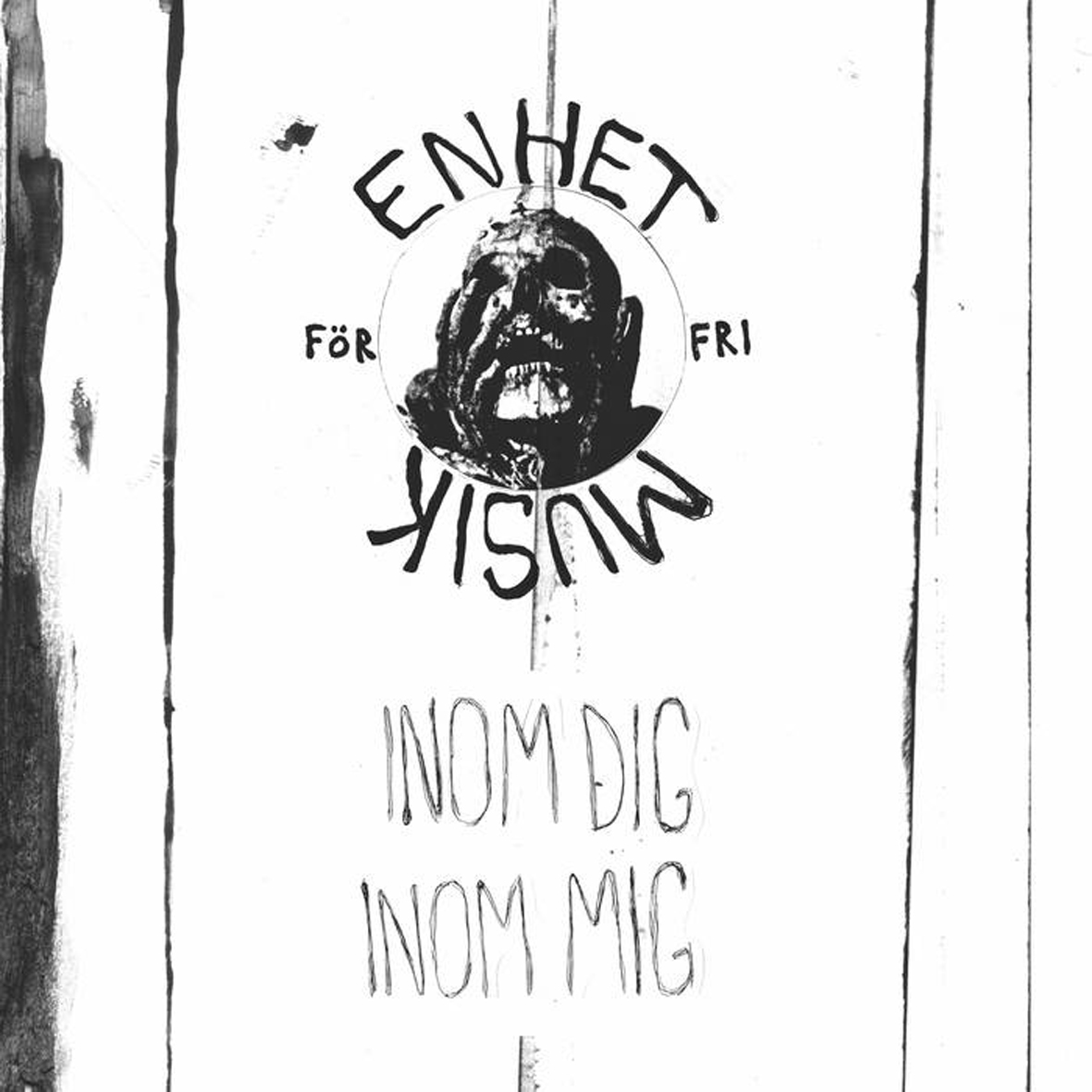 Belgium’s Aguirre Records seems to have quite a talent for digging up some singularly obscure, weird, and surprising releases lately.  The latest one to knock me sideways is this one, a free-folk project that seemingly involves most of the Swedish underground. Ostensibly formed to reignite and continue the tradition of communal psych genius of heavyweights like Pärson Sound, Enhet För Fri Muzik made a rather intriguing detour along the way and wound up deep in idiosyncratic and otherworldly "outsider folk" territory instead.  Even that is a bit of an oversimplification though, as Sofie Herner's alternately fragile, distracted, ritualistic, and trance-like vocals are unpredictably accompanied with everything from saxophones to field recordings of birds and streams.  Admittedly, tight songcraft was clearly not a big priority during these sessions, but Inom Dig casts an absorbing spell of timeless unreality that transcends mere melodies and hooks.
Belgium’s Aguirre Records seems to have quite a talent for digging up some singularly obscure, weird, and surprising releases lately.  The latest one to knock me sideways is this one, a free-folk project that seemingly involves most of the Swedish underground. Ostensibly formed to reignite and continue the tradition of communal psych genius of heavyweights like Pärson Sound, Enhet För Fri Muzik made a rather intriguing detour along the way and wound up deep in idiosyncratic and otherworldly "outsider folk" territory instead.  Even that is a bit of an oversimplification though, as Sofie Herner's alternately fragile, distracted, ritualistic, and trance-like vocals are unpredictably accompanied with everything from saxophones to field recordings of birds and streams.  Admittedly, tight songcraft was clearly not a big priority during these sessions, but Inom Dig casts an absorbing spell of timeless unreality that transcends mere melodies and hooks.
As befits a deeply strange folk album featuring folks like Sewer Election's Dan Johansson and Release The Bats founder Matthias Andersson, Inom Dig, Inom Mig (roughly "Within You, Within Me") has some rather kaleidoscopic and unusual sequencing.  For example, the first side is composed of four sketchlike pieces of varying lengths, while the second side is consumed entirely by the epic 18-minute "Det Ordnar Sig Ska Du Se" ("That's What You'll See").  Only a few pieces feel like actual songs, which both adds to the feeling of spontaneity and generally makes me feel like I am listening to a mysterious jumble of field recordings of an arcane forest ritual (at least sometimes, anyway).  That said, the whole experience opens in comparatively contemporary and straightforward fashion with a brief introduction of trebly strummed electric guitar chords until the following "Se Dig Om" ("See You On") quickly leaves conventional music far behind.  I suppose it still technically counts as a "song" though, as Herner is clearly singing actual words and sticks to a melody, even if she sounds like she is deep in a trance and emanating from a scratchy, hissing old recording.  Despite all that, Herner's vocals are still the closest thing to normalcy in the piece, as the underlying music is a brooding miasma of crackling field recordings, tape hiss, detuned and murky drones, and reverberating string noises–essentially the least likely possible place for a quietly melodic saxophone solo to erupt.  That is exactly what happens though, as the second half of the piece is devoted to a soulful, jazz-inflected, and reasonably competent duet with some sparse nature sounds.
The following "Droppar På Din Hud" ("Drops on Your Skin") takes a similarly aberrant and surprising path, as its central motif is an insistent chord played on an out-of-tune-sounding string instrument over a bed of strange scrapes.  If I had to guess, I would say that it sounds like the source material is culled entirely from the rusting innards of a long-forgotten piano.  Unexpectedly, however, that theme segues into a simple acoustic guitar ballad.  To their credit, Enhet För Fri Muzik even manage to make a simple acoustic guitar melody seem fresh and strange, as it sounds very trebly and close-mic’d and the occasional flubbed notes and string buzz feel like a textural component every bit as important as the melody.  "Stilla Vatten" takes yet another hard detour, resembling a snippet of a mildly distressed old recording of an improv-prone church organist.
As strange and enjoyable as it is, however, the first side of the album is merely a series of appetizers leading up to the main course of "Det Ordnar Sig Ska Du Se."  Structurally, it could not possibly be simpler, as it is essentially just Herner singing a bittersweet melody over an insistently repeating and somewhat broken/out-of-tune sounding arpeggio.  That arpeggio weaves quite an evocative hypnotic spell though, as do the underlying field recordings of what sounds like a windswept field.  Eventually, the arpeggio abruptly stops and the player seems to fumble with a few dissonant chords as the wind swirls around him or her.  Once it starts up again, the field recordings (featuring some birds and mysterious footsteps now) have crept a bit further into the foreground, as has the occasional disruptive wash of static.  While the music itself is weirdly beautiful, the real magic lies in its unreal sense of time and place, as it feels like the band managed to channel the spirit of an ancient Druidic priestess through a secret pagan ceremony in a moonlit grotto.
If I were of a less amenable mindset, it would be easy to dismiss this ensemble as disingenuously childlike in their musicianship or lament the band’s seemingly indifferent approach to songcraft, but that would be completely missing the point.  Though the line is admittedly a blurry one, Enhet För Frei Muzik are not self-consciously dabbling in faux-naiveté so much as trying to use natural, organic sounds in compelling new ways.  In that realm, they succeed admirably and they are smart enough to realize that they need Sofie Harner’s half-pretty/half-ghostly vocals as a coherent thread to ground their more outré impulses.  Escaping conventional tunings and chords while remaining listenable is an impressive feat (especially on an acoustic guitar or piano).  That said, the band's other cunning move was the decision to rely heavily on trance-like repetition, making a virtue of simplicity and wrong-sounding notes.  This album inhabits quite a unique space, as it is deeply psychedelic without any effects and much more tuneful, spontaneous, and direct than most psych-folk (and considerably less self-indulgent or plagued by whimsy).  It also differs significantly from otherwise like-minded artists such as Christina Carter in its raw, found-sound aesthetic.  It is a fine niche to stake out.  Curiously, Inom Dig is the band's debut album (it is a reissue of 2015 cassette) and they have been entirely silent since a flurry of follow-up releases that same year on various small European labels.  I sincerely hope that they are still active, as their otherworldly vision is quite a wonderfully timeless and immersive one.  If not, this remains both a beguilingly strange album and a welcome gateway into quite a rich underground scene that I may have otherwise missed completely.
 
Read More
- Administrator
- Albums and Singles

Bill Orcutt–his first solo electric studio LP—shocks with its space and sensitivity. On this eponymous record, Orcutt mines the expansiveness and sustain possible on the electric guitar, letting notes spin out and decay at the edge of feedback. His pachinko-parlor pacing, marked by unraveling clockspring accelerandos crashing into unexpectedly suspended tones, is still in evidence. But here, his developing melodicism maps a near-contemplative mental realm, orbiting St. Joan-era Loren Connors more than the cascading treble clatter of his duo LPs with Chris Corsano and others. From the first notes of Ornette Coleman’s "Lonely Woman," there's a lucidity and slow-burning lyricism that make Orcutt's plunges into barbed-wire fingerpicking all the more striking. While no one’s about to mistake Orcutt for Jim Hall, you could probably play this for your jazzbo friends (should you be unlucky enough to have them) without raising any eyebrows.
Orcutt's track selection mirrors his obsession with American popular song in its most banal manifestations, as radically reimagined via acoustic guitar on a variety of releases, including 2013's exhaustive Twenty Five Songs 7" box set, and the Mego LP A History of Every One. Many of the songs from those two releases are here–but stretched into new arrangements that explore the upper regions of the guitar neck (hitherto unexplorable on his shakily-intonated acoustic Kay), and lighting up new corners of each arrangement with a sensitivity born from years of reinterpretation. The result is a languid, freeform drift through Orcutt's internal cosmos into galaxies unknown to their original interpreters–and occasionally, Orcutt himself. Most striking is "White Christmas," its careening low-register melodies crashing into complex chords that transcend Orcutt's primitive four-string fretboard.
Orcutt's original compositions are equally striking. One of them—"The World Without Me"—is unique to this LP, and notable for its trebly flurry of Clapton-esque 12th-fret drizzle. "O Platitudes!" by contrast, spins ever-faster in the cadence of a hand-cranked music box, before grinding to a near halt, its higher-key electricity standing in for the moaning vocalizations on Orcutt's acoustic rendition as heard on his 2014 VDSQ LP.
With its deep-space beauty, harmonic complexity, and dark dissonance, Bill Orcutt is a stunning landmark in Orcutt’s form-destroying trajectory.
More information can be found here.
Read More
- Administrator
- Albums and Singles

As the duo Golden Retriever, Matt Carlson and Jonathan Sielaff have explored an ocean’s worth of sound. Primarily working with the intersection of modular synthesis and amplified/effected bass clarinet, the duo has done eight releases for labels like Thrill Jockey, Root Strata, and NNA Tapes. Their music combines an intense emotional immediacy and meditative focus with strong melodicism and an organic, naturalistic approach to experimental electronic sound. Rotations features the duo expanding their sonic palette to incorporate a full chamber ensemble. The results of this stunning collaboration are meditative, lush, and emotionally arresting.
Rotations began when Golden Retriever received a grant from Portland’s Regional Arts & Culture Council to organize and perform new works. The public performances took place in October of 2015 at Portland’s historic The Old Church. For the performances, Golden Retriever created a series of pieces for an expanded ensemble that included piano, strings, wind instruments, percussion, synthesizer, and pipe organ, which became the foundation on which Rotations was built. While their duo recordings and performances are typically developed from studio improvisations that evolve into specific musical structures, in this case Golden Retriever began with simple acoustic compositions, improvisations and fragmented ideas between bass clarinet and piano and used them to develop melodic and harmonic themes. After transcribing the various parts into notation and adding layers of additional instruments, the result of their collage process creates the effect that Golden Retriever are playing the ensemble as their instrument, and through careful arrangements, have integrated improvisation and composition.
Through the course of the creative process of choosing, editing and arranging the pieces, the duo saw a clear theme: a meditation on the cyclical nature of life and on going through something difficult but emerging on the other side of it with hope. Pieces such as "Pelagic Tremor" tell the story of a tumultuous seascape, stormy and churning. "Tessellation" weaves a tapestry of overlapping patterns that are impenetrable and sifting. In contrast, the sounds of "A Kind of Leaving" (whose title is a reference to a Bei Dao poem) evokes quiet and contemplative imagery, and "Thread of Light" is perhaps Golden Retriever's most minimal piece to date, finding beauty in simplicity. Within each piece, the instruments cycle together rhythmically, harmonically, and texturally. And the album itself forms a cycle made up by the ebb and flow of each piece that is both dynamic and engaging.
More information can be found here.
Read More
- Administrator
- Albums and Singles
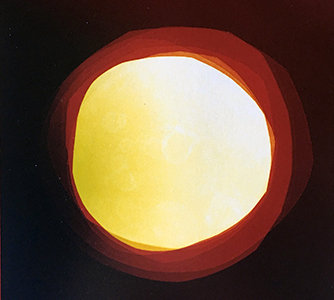 Locrian is still an active band, but vocalist/keyboardist Terence Hannum has added another side project to his roster: The Holy Circle. Featuring his wife Erica Burgner-Hannum on vocals and Nathan Jurgenson (Screen Vinyl Image) on drums, the project could not be more different than his other recent one, the anti-fascist Axebreaker (recently reviewed). With The Holy Circle the mood is much more peaceful and elegant, with an emphasis on melody and songwriting, but maintaining that experimental edge Hannum is known for.
Locrian is still an active band, but vocalist/keyboardist Terence Hannum has added another side project to his roster: The Holy Circle. Featuring his wife Erica Burgner-Hannum on vocals and Nathan Jurgenson (Screen Vinyl Image) on drums, the project could not be more different than his other recent one, the anti-fascist Axebreaker (recently reviewed). With The Holy Circle the mood is much more peaceful and elegant, with an emphasis on melody and songwriting, but maintaining that experimental edge Hannum is known for.
First, it cannot be ignored that The Holy Circle sounds extremely inspired by The Cure circa 1981 (and a bit of 1982, sans that trio's violence).This is immediately apparent on the opening "Paris":galloping, tom-heavy drumming and lush, yet slightly dissonant string synthesizer arrangements bear a distinct resemblance to the sound of Faith.However, Burgner-Hannum's vocals are significantly different than anything Robert Smith warbled out, so the final product is a different beast entirely, with a heavy sense of melody and just the right amount of edge.
The drumming/synth sound is a consistent thread throughout the album, but it never results in something akin to a tribute act.On "Early Morning," Hannum's synth sits in just the right amount of murk, with Jurgenson's drumming expanding from a metronomic opening into a more complex arrangement, it makes for an excellent balance of pop and experimentation.Similarly diverse is the initially stripped-down "Shut Out," which begins with little more than a pulsating slow synth sequence.Before long the mix is fully fleshed out with drums and vocals, coming together as one of the lushest moments on an album full of them.
At other points on the album, the needle leans more in the pop direction.The more upbeat, multi-tracked vocals of "Hearts Called" give a bit more light to the album.Driven by a more piano-type lead, there are contrasts with a bit of noisy synth, but the strong, snappy snare that kicks in keeps it buoyant."The Refugee" may be a slow paced song, but the shimmering layers of synthesizers that build up, giving a nice variation to the sound, mixed with Burgner-Hannum's extremely expressive and powerful vocal performance result in one of the album’s highlights: a sense of grandeur and power unlike any other.
The album’s closer, "Basel," ends the album on a similar note to how it began with "Paris":big, booming drums and upfront synthesizer work again make it clear what the primary influences are on The Holy Circle's sound.However, what makes it obviously unique is the shifting structure the trio uses, from an initially stripped down opening into an epic conclusion, it manages to pair regal beauty with a catchy, memorable structure that seems to just tease for future work.
Having only issued a cassette EP and a single song lathe 7" preceding The Holy Circle, this trio have already solidified themselves as experts in a modern revival of the classic 4AD sound, but bearing that as an influence, rather than an imitation.From Nathan Jurgenson’s expressive drumming, to Terence Hannum's melodic, yet occasionally harsh-edged synth work, to Erica Burgner-Hannum's distinctive, beautiful vocals, The Holy Circle is a band strictly of the present day.The perfect balance of the familiar and the fresh, it is an exceptionally captivating album.
samples:
 
Read More
- Administrator
- Albums and Singles
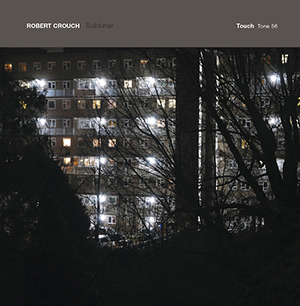 Crouch's last release, A Gradual Accumulation of Ideas Becomes Truth (Line), was a heavily conceptual work touching on location and memory that, even divorced from its intellectual underpinning, was an excellent piece of sound art. Sublunar may not be as steeped in concept, but again the audio (a live performance mixing existing material and field recordings) is the most important facet, and again he excels in creating a disorienting piece of familiar and unfamiliar sounds that blur together wonderfully.
Crouch's last release, A Gradual Accumulation of Ideas Becomes Truth (Line), was a heavily conceptual work touching on location and memory that, even divorced from its intellectual underpinning, was an excellent piece of sound art. Sublunar may not be as steeped in concept, but again the audio (a live performance mixing existing material and field recordings) is the most important facet, and again he excels in creating a disorienting piece of familiar and unfamiliar sounds that blur together wonderfully.
Sublunar is the result of a live performance utilizing source material from fellow artists Rafa Esparza and Yann Novak as part of mas gestos y mas caras, a multimedia performance including sculpture and performance art.His reworking of the material is drastic, resulting in a performance split into four pieces of a very different sound and sense.A light static ambience enshrouds "Descension," capturing a variety of found sounds, like an insistent beeping sound that could be almost anything.Crouch works the various layers of sound together, coming together at times lush and rich, and at others thin and harsher in nature.This constant unending flow makes for a complex, captivating piece of sound.
"Brick by Brick" continues with the delicate water sounds from the previous piece, but at first Crouch keeps the mix sparse.What he does leave in the mix helps to build that sense of space and distance, like the architectural structures of his previous album.The emptiness soon becomes crowded however, as Crouch adds a droning, engine like noise that becomes denser and denser, engulfing the mix before letting it collapse.
The following "Listen to the Sound of the Earth Turning" has a more hushed, meditative sensibility to it fitting the title.With the static hum and detuned radio noise that define the opening of the piece, Crouch conjures the sense of hovering in air, off of the earth but not quite in space.This is only strengthened by the blowing winds that surge throughout, not cold or frigid in nature, but giving the feeling of hovering in open space.
The final part of the performance, "Coda (Sailing Stones)" continues the sense of space from before, but Crouch slowly brings the work back down to earth.The openness is mixed with field recordings of an unspecific nature; environmental sounds that could be recorded anywhere or nowhere.With this he adds some gorgeous tones and synth-like buzzing, shaped into a melodic progression before pleasantly fading away.
Separated from the source material, Sublunar may not have the same conceptual nature of his previous work, but his knack for mixing familiar sounds with unfamiliar ones is still strongly present.Here he manages to create a space that is both comfortable and alien, where the ambiguity simply adds to the quality of the sound.Given this is a live performance; it just makes this record all the more impressive.
samples:
 
Read More
- Administrator
- Albums and Singles
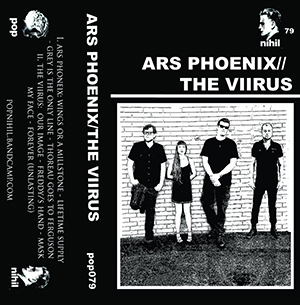 This split tape manages to capture what sounds like the final Ars Phonenix release (though vocalist/guitarist/keyboardist Jon Glover and keyboardist/vocalist Caitlyn Grimalkin are continuing as Pass/Ages), and one of only a handful of works by Adam Batley's Viirus project. Besides both hailing from the wild lands of Florida (not what I would consider a hotbed for electronic music), they also share the commonality of creating skeletal, yet catchy and moody electronic pop, making for an exceptional pairing.
This split tape manages to capture what sounds like the final Ars Phonenix release (though vocalist/guitarist/keyboardist Jon Glover and keyboardist/vocalist Caitlyn Grimalkin are continuing as Pass/Ages), and one of only a handful of works by Adam Batley's Viirus project. Besides both hailing from the wild lands of Florida (not what I would consider a hotbed for electronic music), they also share the commonality of creating skeletal, yet catchy and moody electronic pop, making for an exceptional pairing.
If it is truly the final release from Glover/Grimalkin and Mike Cruickshank, they are going out on an especially high note.Their four songs fit in consistently with their previous split with Burnt Hair and their Violent Rain LP with mostly midpaced structures and the occasional uptempo surprise.Lead by some excellently produced snappy synthetic drums, "Wings of a Millstone" opens their half of the tape on a strong note.Vocals are kept in the distance to maximize the sense of space created, which also accentuates the slow guitar melodies Glover provides.
The trio begin "Grey is the Only Line" with a wonderful pulsating synth line with rhythmic accents, and the guitar melody again making for an excellent focal point.The overall feel is slow, dour, and depressing, but the heavy syndrum sound gives it the edge to make it stand out strongly.The closing "Thoreau Goes to Ferguson" is similarly paced, but with a distinctly strong bass line, and Glover’s vocals mixed more up front compared to most of the other album.
The high point for the Ars Phoenix half is the previously released (as a video) "Lifetime Supply."With its faster tempo and slightly harder drive contrasting the more moody songs very well, it excels in its energy and catchiness.That edge, plus a memorable chorus from both Glover and Grimalkin, results in one of the band’s strongest works, and one that makes their imminent dissolution even more disheartening.
On the other half, The Viirus begins with at first a loose progression of analog synths on "Our Image" that quickly transitions into a fast paced drum machine lead piece.Batley's vocals eventually appear, muted in a very fitting manner.The closing song "Forever (Unlasting)" has a similarly stripped down, but extremely effective arrangement.A catchy synth sequence and snappy drums result in an exceptional sounding work; a mix that may not be overly complicated but excels from the basics.
The sharp drum machine programming stands out sharply on "Freddy’s Hand" with throbbing synths behind, giving a dark, bleak feel immediately to the song.With Batley’s vocals taking on a more monotone, disconnected sound, the piece comes together with a strong hint of EBM to it.The following "Mask My Face" goes in a different direction, immediately apparent from the stammering 808 beat that opens the piece up.The intentionally Spartan arrangement, and the heavily vocoded vocal style makes for an oddly loose piece amidst the more structured songs.
Ars Phoenix's more moody half of this tape is balanced very well with The Viirus' synthetic, yet more driving sound overall.With the latter’s eccentricity and the former’s stand out "Lifetime Supply," the total package is a superlative one.My only gripe is that neither of these bands were active when I served my time in Florida, since it would have made for a much better experience overall.
samples:
 
Read More

